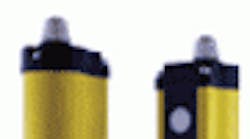Most production line managers value safety for the critical role it plays in helping to protect personnel, reduce injuries, and meet compliance demands. These are valid objectives, but safety can also boost productivity and profitability. This includes financial returns beyond the benefits of reducing costs associated with accidents and medical expenses.
A systematic approach
To optimize functional safety and maximize benefits, system designers must deeply understand the manufacturing process; machinery limits and functions; and the ways in which people interact with machinery. They must also take a practical approach to safety design and be willing to implement new safety technologies and techniques.
The functional safety lifecycle, as defined in standards IEC 61508 and IEC 62061, provides the foundation for this more systematic design process. A key objective here is addressing the cause of accidents.
Previous standards relied on prescriptive measures defining specific safeguarding; new standards are performance-based, making it easier for designers to quantify and justify safety. The methodical approach allows tailoring of safety functions to application complexity, and improves machine sustainability.
Safety lifecycle phases
Conducting a risk assessment is the first phase of the safety lifecycle, and helps determine what hazards exist, and which safety mechanisms should be implemented to help ensure adequate protection against them. It provides the basis to:
-
Help eliminate hazards using inherently safe design concepts
-
Employ protective measures with hard guarding and safety devices
-
Implement complementary safety measures including personal protective equipment (PPE)
-
Implement relevant procedures, training, and supervision
The functional lifecycle then provides the framework for several effective design-in safety concepts — including passive, configurable, and lockable system designs.
Passive components
Two reasons that operators might elect to bypass safety systems is that the systems are cumbersome and impractical or do not easily accommodate maintenance and operating procedures. An effective passive system design performs its function automatically — with little if any effort required from the user.
For example, many manufacturers use safety interlock gates that require operators to initiate the safety function. Even if it only takes 10 sec to open and close the gate for each cycle, that time accumulates over a 200-cycle day. In contrast, with a passive light curtain, the operator simply breaks the infrared barrier when entering a hazardous area to bring the operation to a safe stop.
Configurable components
Configurable designs allow operators to alter the behavior of the safety system based on the task they need to perform.
For example, an operator may need machine access plus some form of power enabled to perform a maintenance function, clear a jam, or teach a robot. The initial risk assessment identifies and defines all the tasks, including these, that must be performed on the machine with or without power. In most cases, inexpensive components such as push buttons, selector switches, and lights are all that is needed to achieve an acceptable level of safety.
Lockable components
Using a lockable system design to systematically reduce mean time to repair (MTTR) can also boost productivity: This approach allows operators to select a safety configuration, and then lock it in place at the point of entry. A lockable design also allows use of the safety system in lieu of lock-out/tag-out (LO/TO) for routine maintenance and setup.
For example, in a LO/TO situation, operators may need to use six locks to safely shut down a line including electronic, pneumatic, and robotic systems. Shutting down the entire machine can be time-consuming and inefficient. In contrast, if the safety system meets the target safety level and complies with standard ANSI Z244-1, it can be used to disable hazards. In this case, LO/TO is not required.
For more information, visit rockwellautomation.com/services/safety/ or call (440) 646-3434.


